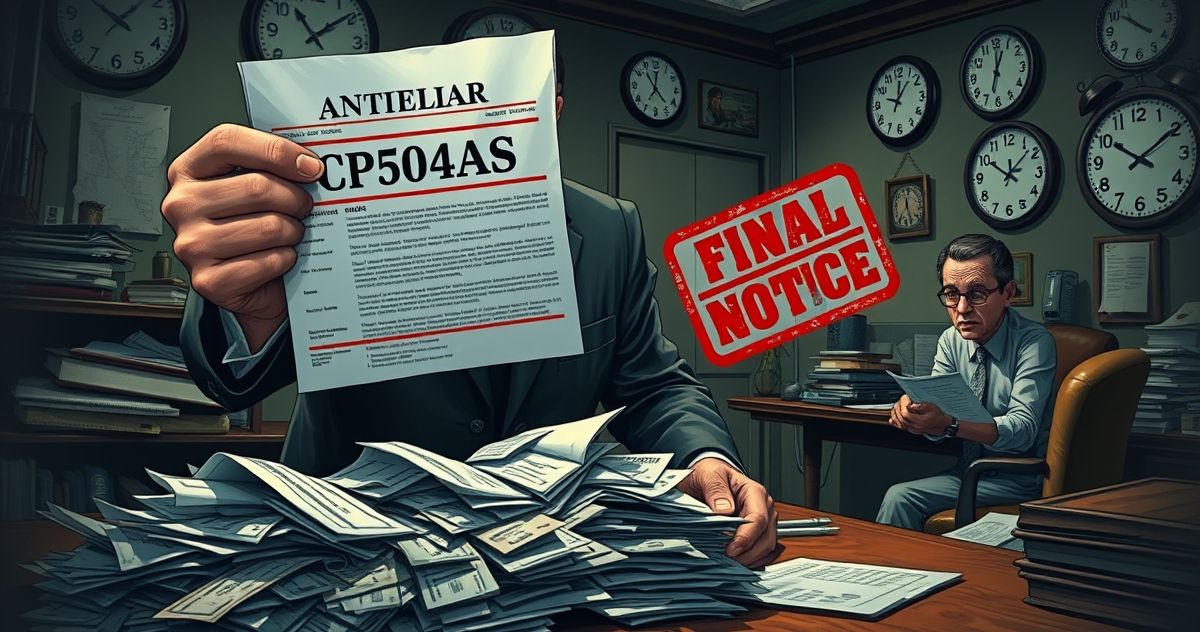Understanding the CP504AS Notice: A Comprehensive Guide
The CP504AS Notice is a crucial document issued by the Internal Revenue Service (IRS) primarily to notify taxpayers about unpaid tax debts. This notice serves as a final warning before the IRS escalates unpaid tax enforcement actions. Understanding the CP504AS Notice, its implications, and the steps you must take upon receiving it is vital for effective financial management and ensuring compliance with federal tax obligations.
What is the CP504AS Notice and Its Primary Purpose?
The CP504AS Notice is typically issued to inform taxpayers of a serious matter: a balance due is still outstanding despite previous attempts to collect it. It’s often referred to as the “Final Notice of Intent to Levy and Notice of Your Right to a Hearing.” Its primary purpose is to demand immediate payment of tax liabilities to avert levies against the taxpayer’s assets or income.
This notice signifies the IRS’s intention to potentially levy your state tax refund as a means of settling the debt, should you fail to remit the outstanding balance. It is critical for taxpayers to address the issues outlined in this notice promptly to prevent further enforcement actions.
Key Features of the CP504AS Notice
- Official Warning: The CP504AS serves as an official warning that the IRS plans to levy or garnish wages, bank accounts, and other assets to satisfy unpaid tax debts.
- Deadline for Payment: The notice includes a specific deadline by which taxpayers are expected to settle their debts or propose an alternative payment solution, such as an installment agreement.
- Implications of Non-Compliance: The document details the potential consequences if the taxpayer does not respond by the given date.
- Right to a Collection Due Process Hearing: Taxpayers are informed about their right to request a Collection Due Process (CDP) hearing before any levy actions proceed.
Relevant Filing or Compliance Requirements
Upon receiving a CP504AS, compliance with the requirements is essential to prevent severe financial consequences. Here are the actions taxpayers should consider:
- Immediate Payment: The most direct way to resolve the issue is to pay the full outstanding amount by the deadline provided.
- Payment Plans: For those unable to pay in full, contacting the IRS to negotiate an installment agreement can prevent immediate levy actions.
- Submitting Offers in Compromise: Taxpayers may also explore if they qualify for an Offer in Compromise, which allows settlement of tax liabilities for less than the owed amount.
- Request a CDP Hearing: Filing for a Collection Due Process hearing can grant extra time and allow taxpayers to dispute the debt or payment terms.
Penalties or Consequences for Non-Compliance
Ignoring a CP504AS Notice can lead to several severe penalties, including:
- Tax Levies: The IRS may levy your bank accounts, garnish wages, or seize other assets to settle the tax debt.
- Interest and Penalties: Continued non-payment will accrue additional interest and penalties, increasing the total amount owed.
- Credit Impact: IRS actions could negatively affect your credit score if levies and liens are placed on your accounts and properties.
- Legal Consequences: Ongoing non-compliance can also trigger legal actions, which can complicate financial liabilities further.
The Importance of the CP504AS Notice in Tax Compliance
The CP504AS Notice plays a significant role in tax compliance and financial responsibility. It acts as a final opportunity for taxpayers to resolve existing tax debt before enforcement actions are taken, underscoring the importance of understanding and responding to IRS communications promptly.
Receiving this notice highlights the significance of maintaining proactive tax compliance to avoid escalated collection actions. It also serves as a reminder of the IRS’s commitment to enforcing federal tax laws.
Conclusively, the CP504AS Notice is a critical alert that requires immediate attention. Taxpayers are advised to review the notice carefully, assess the payment options available, and take decisive actions to prevent further steps by the IRS. Seeking professional financial or legal consultation can be beneficial in navigating the intricacies of tax debt resolution, thus ensuring a more secure financial standing and compliance with tax obligations.

